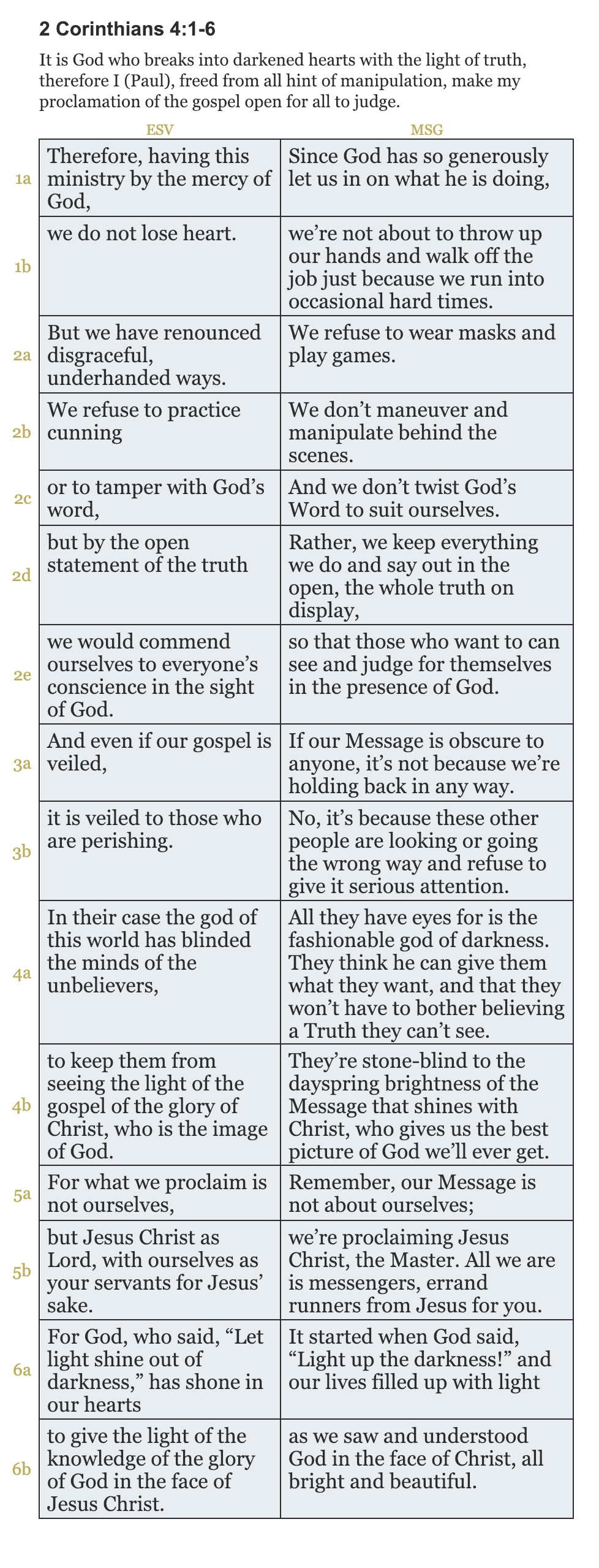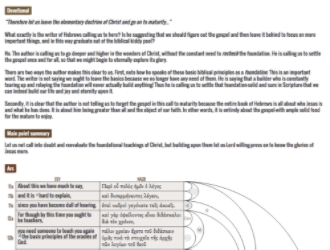Lesson 6 | Expansion and contraction: the art of summarizing
More examples to help you
In each example below, the Scripture text is in the left column, a paraphrase in the right, and the main point summary at the top.
Example 1

We looked at 2 Corinthians 4:1-6 in detail in the last lesson and determined that the main point was at 2e, “we would commend ourselves to everyone’s conscience in the sight of God.” There are two primary supporting ideas that are key to Paul’s assertion. First, in 2a-d, Paul makes clear that he will not use manipulative means to communicate but will openly speak the truth. Second, in 5-6, Paul gives the primary basis for his methodology, namely, it is God who opens blind eyes and darkened hearts.
So I have three key pieces to my summary: the main point, and two primary supports.
Main Point Summary It is God who breaks into darkened hearts with the light of truth, therefore I (Paul), freed from all hint of manipulation, make my proclamation of the gospel open for all to judge.
Notice that I have changed the order in which the pieces are presented in the text:
Bible text: support #1, main point, support #2
My summary: support #2, support #1, main point
Example 2

I used 1 Corinthians 15:20-28 in lesson four as an example of using a paraphrase to unpack all the logical connections. In my own study, I concluded that Paul states the main point right at the front of this passage. Having previously defended the reality of Christ’s resurrection in 15:1-19, Paul now connects another truth—that Christ’s resurrection is the firstfruits of a harvest of life from death. This connection is made right away in 20a-b. The rest of the passage supports this assertion by explaining how (21-26) and why (27-28) this full resurrection harvest will occur. So, again I have three key pieces to include in a summary: main point, support (how), support (why). In this case, I chose to keep the same order as the text.
Main Point Summary The fact of Christ's resurrection points to the reality that his resurrection is just the beginning. All those in Christ will rise too–in precisely the way God has ordained, signaling Christ's victorious reign over all things.
Notice the great number of details that I have left out, aiming to concisely get at the nub of Paul’s argument.
Example 3

Psalm 46 is naturally divided into three parts by the Hebrew idiom “Selah,” which is generally regarded as a marker for a musical pause. The first section (1-3) contains the main point, specifically stated in the conclusion drawn in v.2, “therefore, we will not fear.” Both of the remaining two sections provide a reason why God’s people cannot be afraid and then close with the same response: “The Lord of hosts is with us; the God of Jacob is our fortress. Selah.”
My summary puts the two reasons (or anchors) at the front and then adds the response/conclusion as the main point at the end.
Main Point Summary We have these two anchors in the midst of global conflict and turmoil: 1) God's life-giving, life-sustaining presence gladdens our hearts. And 2) seeing his sovereign hand at work, his word to us is simply, "Be still and know that I am God." What can we say but, “The Lord is with us!” Therefore, we will not tremble in fear.
This summary captures the main point well, but it is not very concise. It is four sentences long and brings in some details that detract from its simplicity. Some more work is needed to whittle this down while maintaining accuracy.
Main Point Summary, take 2 In the face of global conflict and turmoil, God’s presence gladdens our hearts as he invites us to find rest in him. Therefore, we will not tremble in fear.
Example 4
Below is a link to a published page at Biblearc.com that presents a study of Hebrews 5:11-6:3 by Biblearc’s developer and lead instructor, Andy Hubert. It contains an excellent summary of the passage based on careful study of the text.
